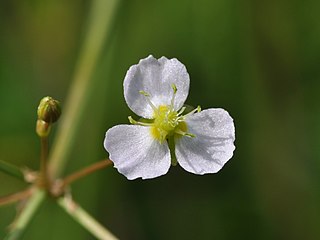
Alisma plantago-aquatica, also known as European water-plantain, common water-plantain or mad-dog weed, is a perennial flowering aquatic plant widespread across most of Europe and Asia, and apparently spread elsewhere in both the Old and New World.

Alisma is a genus of flowering plants in the family Alismataceae, members of which are commonly known as water-plantains. The genus consists of aquatic plants with leaves either floating or submerged, found in a variety of still water habitats around the world. The flowers are hermaphrodite, and are arranged in panicles, racemes, or umbels. Alisma flowers have six stamens, numerous free carpels in a single whorl, each with 1 ovule, and subventral styles. The fruit is an achene with a short beak.

Damasonium alisma is a species of flowering marsh plant known by the common name of starfruit. Its native range includes parts of Great Britain, France, Portugal, Spain, Italy, Greece, Russia, Ukraine, Moldova, and Kazakhstan.

Luronium natans is a species of aquatic plant commonly known as the floating water-plantain. It is the only recognized species in the genus Luronium, native to western and central Europe, from Spain to Britain to Norway east to Ukraine.

Caldesia is a genus of aquatic plants. It includes three living species widespread across Europe, Asia, Africa and Australia. The genus "has an extensive Oligocene through Pleistocene fossil record in Eurasia," and has been found in fossil strata of the United States as well. Ten fossil species have been described for the genus.

Heteranthera limosa is an annual flowering plant in the water hyacinth family known by the common names ducksalad and blue mudplantain. It grows in shallow water or on mud. It is considered a threatened species in parts of the central United States, and an invasive species weed in California, where it is a nuisance in rice paddies. It is also occasional in Florida waterways.

Alisma lanceolatum is a species of aquatic plant in the water plantain family known by the common names lanceleaf water plantain and narrow-leaved water plantain. It is widespread across Europe, North Africa and temperate Asia. It is naturalized in Australia, New Zealand, Oregon, California and British Columbia. It is considered a noxious weed in some places.

Sagittaria montevidensis is a species of flowering plant in the water-plantain family Alismataceae. Common names include giant arrowhead and California arrowhead.

Alisma subcordatum, the American water plantain, is a perennial aquatic plant in the water-plantain family (Alismataceae). This plant grows to about 3 feet in height with lance to oval shaped leaves rising from bulbous corms with fibrous roots. Any leaves that form underwater are weak and quick to rot; they rarely remain on adult plants. A branched inflorescence with white to pink 3-petaled flowers blooms from June to September. The seeds are eaten by waterfowl and upland birds. Native Americans dried and ate the submerged rootlike structures. The species name subcordatum means "almost heart-shaped".

Alisma triviale, the northern water plantain, is a perennial semi-aquatic or aquatic plant in the water-plantain family (Alismataceae).

Potamogeton gramineus is a species of aquatic plant known by the common name various-leaved pondweed, variableleaf pondweed, grass-leaved pondweed or grassy pondweed, native to the northern hemisphere where it grows in shallow, clean water.

Sagittaria longiloba is a North American species of flowering plant in the water plantain family known by the common name longbarb arrowhead and Gregg arrowhead.

Potamogeton obtusifolius, known as blunt-leaved pondweed, is an aquatic plant in the genus Potamogeton. It grows mainly in mesotrophic to eutrophic lakes, ponds and ditches, rarely in brackish water. It occurs primarily in Central Europe, the British Isles, Fennoscandia and eastern North America.

Caldesia parnassifolia, is an aquatic species in the Alismataceae. It is found in slow-moving fresh water.

Baldellia ranunculoides, the lesser water-plantain, is a species of flowering plant in the family Alismataceae.

Sagittaria rigida, the sessilefruit arrowhead or Canadian arrowhead, is an aquatic plant species. It has narrow oval leaves rather than the iconic arrowhead shaped leaves of species like the Sagittaria latifolia. it has sessile female flowers, from whence its name comes. Its flowers are very similar to other plants in the Sagittaria family, with three white petals.

Sagittaria kurziana, common names springtape and strap-leaf sagittaria, is a perennial aquatic plant. It grows up to 250 centimetres tall. It has long, narrow, flat leaves that float on the surface of the water, up to 250 cm long but rarely more than 15 millimetres wide. These form huge masses of ribbon-like leaves flowing back and forth with the current. Inflorescences also float on the surface, the white flowers very often submerged.

Sagittaria graminea, the grassy arrowhead or grass-leaved arrowhead, is an aquatic plant species native to eastern North America.

Sagittaria subulata, the awl-leaf arrowhead, narrow-leaved arrowhead or dwarf sagittaria, is an aquatic plant species.

Alisma canaliculatum, commonly known as channelled water plantain, is a species of plants in the Alismataceae. It is native to Japan, Korea, the Ryukyu Islands, Taiwan, the Kuril Islands, and China.





















